As you may or may not have seen, we busted a box of Panini’s new high-ish end basketball offering on video a couple of days ago. We promised both a review and a contest, so here’s both wrapped up into one lovely little McDonald’s apple pie box package!
Base Set
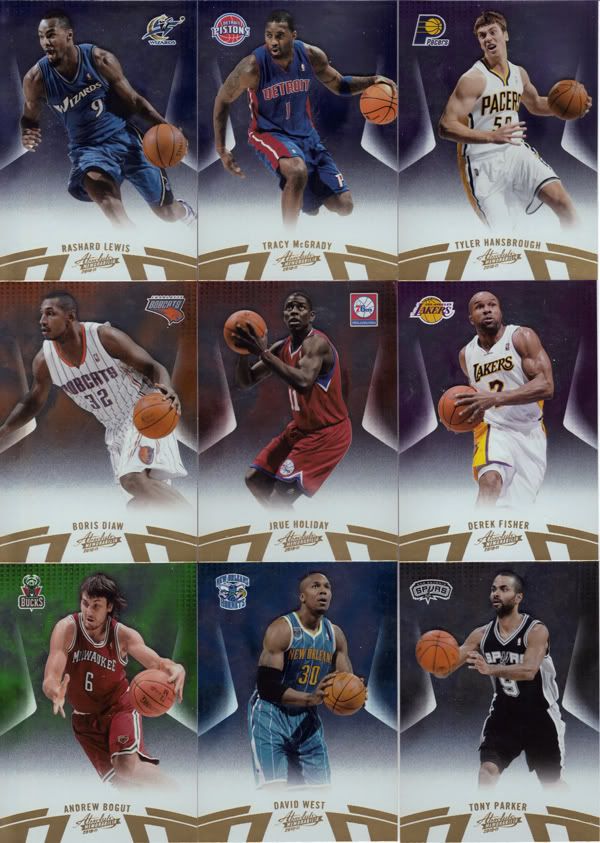
Players Andy Knows Count: 1
You’ll notice a theme in this review: I know very little about basketball. I mean, in understand the rules and the goals and the boom shaka lakas and all that, but I have absolute(pun)ly no idea who most players are and which ones as any good. What’s worse is that I have no frame of reference for telling who is good. How many points per game is good? I know MJ got 55 in a playoff game once and that was news (and like 50% of the scoring done by the Bulls that night) so that’s a high water mark. But what does your regular, everyday Ryan Theriot type put up? And defense? No clue. A bunch of blocks and steals is probably good, but how much is a bunch?
Okay, enough of my ignorance. These base cards represent the whole hall of base from our one box and I think they look just fine. The stock is relatively solid and the action shots look nice. I’m not a huge fan of the design- in fact, I almost never like a base card that has the player cut out of the real action and tossed in front of some Tron-like grid or some abstract (often symmetrical) design like the one we have here. Show me a nice photo of a player on the field over this any day. Of course, basketball is at a disadvantage because they play on lame, evenly-lit same-colored floorboards every night. So, as far as base design in a semi-high end set like Absolute goes, these are fine. Not quite an afterthought (though only one line of stats on the back does beg the question) but also not cards with any “wow” factor.
I mention this in our video break, but
Bonus question: Can you guess which player I know in the above scan?
Inserts

4 for 7 this time!
I make no excuses for my love for the Stargazing inserts. Anything with false color deep space imaging is basically like a giant piece of cake for the big fat nerd inside of me. That being said, even that insert set suffers from Panini-itis. That is, lots of dead space where they can toss a plain white swatch or sticker auto. I don’t know anyone who thinks this is a good idea except for Panini’s efficiency guru (not that I think they actually have one, but you catch my drift). The sad thing is that the only set that eschews this unfortunate policy is the vertically-oriented Hoopla set, a decent (if busy and disappearing-footed) set in its own right. The funny thing is, the relic version of this insert doesn’t work well at all from what I’ve seen on eBay- it’s too crowded. So what’s the solution? It’s obvious to me: stop cannibalizing insert sets for relics and autos or come up with a design that truly works equally well with both versions. I’m not asking the impossible- Topps does it with every single set.
You’ll also see some base set SP/parallel versions up top there. I think they’re going for a refractor kind of vibe with the Spectrum shiny, but it took a second glance for me to notice the difference- even with the numbering and “Spectrum” tag right on the front of the card! That’s not too big a gripe because at least they’re all numbered and I have some serious trouble telling refractors from base in Topps’ chrome products too. The ticket-like Frequent Flyer is of a sweet classic player from my youth and I have to say that I am just plain done with ticket-related sets, inserts and parallels. There’s nothing compelling about the look of a ticket. Let’s move on folks. Overall, I was underwhelmed with the inserts, which is becoming something of a pattern with Panini products for me.
Hits
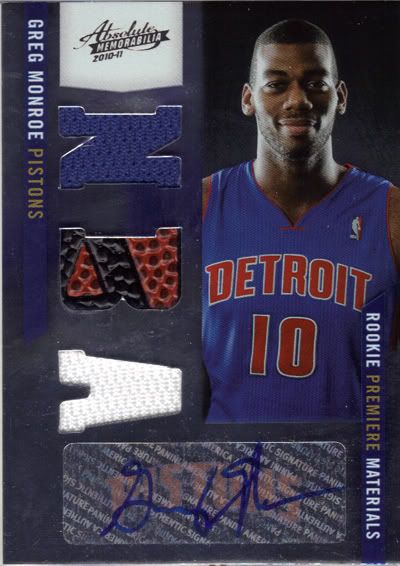
I like to think we got the "A" that ball there. Anyone care to disagree?
Okay, here’s the bread and butter for Absolute. Each pack of Absolute contains a hit. And each box contains at least one auto/relic (often a Rookie Premiere Materials like Mr. Monroe up there). The autograph checklist is deep and spans a large range of subjects from mid-tier draft picks to serious legendary players. All autos are stickers (another unfortunate Panini trademark) which is a shame because those RC Premiere cards would look loads better with a solid on-card signature. I absolutely love the ball piece and I wish more companies would do it (with actual game-used balls and not just the one that dude was holding in the picture). These are hurt by their high numbering (/499) and relatively easy pull status but are not bad looking cards. In fact, design-wise this is my favorite of the bunch.
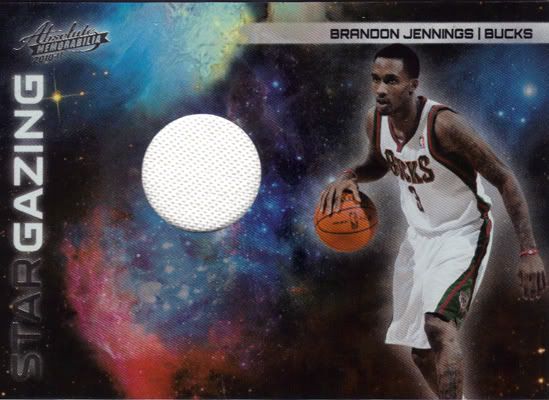
Billions and billions...
I was so stoked we pulled one of these. Unfortunately, every problem I have with the “leave space for the relic” tactic is evident here: It seems really small and there’s still room for an auto below it, messing up the feng shui of the card. Every time I see one of these relics with the space for the auto below it, it’s just a sad reminder that I didn’t get the best version of this card. Woe is me. This card is numbered to 49 and I’m not sure how it differentiates from the ones that are numbered to things other than 49. I noticed on the non-relic versions that the “STAR” can be either gold or silver so I’m guessing the gold version of this guy is numbered to something higher. Barely-there parallels are a pet peeve of mine and that’s a scar on the face of the beautiful nebulae hanging out behind Brandon there.
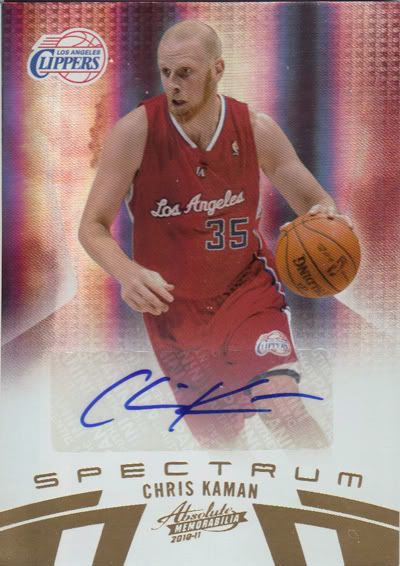
A young Ron Perlman, genetically crossed with Jake Busey, storms on to the court... and into our hearts.
This guy is numbered to 99 because he’s the Spectrum version I think. Once again, the sticker auto detracts from what would be a really nice looking card. I will admit that these look much better in person than on scan. However, from what I can gather, we didn’t exactly get the next Karl Malone in this card, so I suppose I could complain about player selection like this in a higher end product, but I’ll leave that to you guys in the comments.
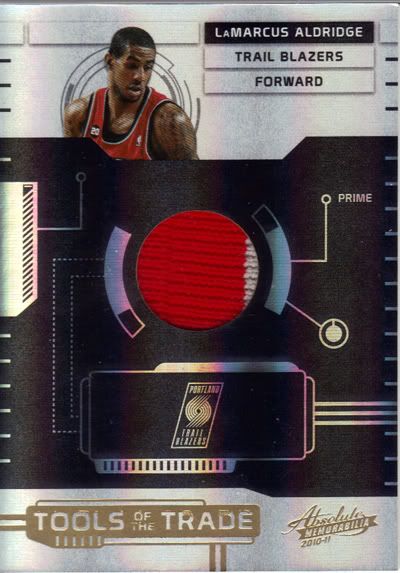
I love a heads up display that tells me that the relic I got is prime.
This is the prime relic that I think we were guaranteed in our box. It could have been worse, especially as this fella is #/25 (and I know his name!). The design of this set is a bit puzzling but it does at least have a reasonable purpose: show off that prime relic! I do wish that the photo was a little bigger… maybe if we ditched that space for a sticker below the relic hole, we’d be in better shape. If you’re not laughing right now, it’s because you missed that I just typed “relic hole.”
Conclusion
There’s something to be said for consistency, and Panini provides that every time. I’ve never had any major problems with their products and this one is no exception. I will confess that the too-similar designs between many of their sets is a blemish on their record, and there’s always an element of parallel-happiness that grates on me. Since I’m not a basketball expert, I have to rely on eBay to gauge my value score and eBay sayeth: not good. We didn’t hit any big names, so we’re stuck with a box that would likely have disappointed many purchasers. That’s the name of the game in any product of course, and especially with high end 4-pack products, you’re really rolling the dice. That’s not to say I didn’t like this box or the product- it just needs something to set it apart from the other Panini basketball products to push it over the edge from “That was okay” to “I can’t wait to see what they do with it next year!” On-card autographs would probably be enough but, barring that, this set needs a real kick in the design pants to make it more than just another 4-hit-per-box-kind-of-like-Contenders-in-most-respects product.
Design – **
Set Collecting – *
Inserts – **
Hits – ****
Overall – **.5 out of 5
Contest
And now the moment you’ve all been waiting for! There are only a handful of cards here, so one lucky winner gets them all. I’m going to try to make this contest a learning experience for me. So here’s how you enter.
Leave a comment below telling me two things:
1. Who is the best player we pulled in this box?
and
2. What are good stats to look at to help me tell who is good?
Don’t forget to give me some ranges for number 2 there- I know a .300 batting average is great, but what should I be looking for in PPG, FG%, etc? Oh, and don’t forget your email address!
You have until this Thursday night at 11:59PM CST to enter so get your entries in quickly and spread the word!

I don’t want to enter the contest, but nice review and box. Greg Monroe is by far in my opinion the best card of the bunch. He had a very solid last half of the season for Detroit. His cards do see some action, and if he could elevate his scoring avg. they’d go up further.
For finding ‘prospects’ in the NBA – average stats out Per 48 mins. this will tell you what the guy might be capable of doing if he got tons of mins.
Minuets per game in the NBA is a huge stat – as if you aren’t on the floor, you have no chance of getting any stats yourself. Most teams have tight rotations that only change if someone gets hurt. Wes Matthews (for Brandon Roy) was probably the best example of a young player getting a lineup spot because of injury this season. Tyler Hansbrough, even Ryan Anderson, and others were able to creep into lineups this season because of poor play or injuries.
PPG is where the money is in cards – but only a select few players are capable (and given the chance) to put up 20+ points per night. Finding young players on ‘bad’ teams like Jordan Crawford and even Blake Griffin are good because the don’t have Kobe or LeBron taking 20+ shots per game. Often times it takes several years for collectors to fully appreciate a player (Rose for the Bulls is a good example of the guy getting the ‘love’ from the NBA, ESPN and others this year … but it will be someone else next year).
After that, its winning. Championships – and winning many of them is what the NBA has become about. Only a select number of teams have won over the entire history of the NBA – so getting those cards before they go on a run is something that can be done too.
I didn’t know anyone in the NBA outside the ‘top’ players … but playing in a 10+ team fantasy basketball league is a good way to learn about the Kris Humphries and Chase Budinger’s of the NBA.
1. clyde drexler
2. i would look at ppg cause thats where the money is at when you want to win games!
Aldridge is the hit of the box to me, prime jersey of a young superstar. Colin’s got it on how to see what the younglings can do, I’m just not into prospecting. It looks Landry and Monroe both had alright rookie seasons though. Single best player overall is probably Elvin Hayes, followed (very closely) by D-Rose, if only because this is only his 3rd season. Clyde Drexler and Chris Paul are easily the next best, followed Tyreke Evans, Tony Parker (more for his rings than the stats he puts up), and Brandon Jennings. No one you pulled is really a scrub within the game itself though.
Your awkward white guy auto is even a surprisingly serviceable player, though not a big star by any stretch.
For scoring, 20+ ppg is a star or superstar (if they do enough other things or are just popular enough) in the game, though they might always not get the respect they deserve. For example, it’s fair to say Monta Ellis is the Milt Pappas to Derrick Rose’s Don Drysdale. He only has slightly lesser stats (24.1ppg/5.6apg to D-Rose’s 25ppg/7.7), but plays on a bad team no one pays attention to. Also, 25ppg and up is the rarefied air, everyone is a superstar there.
For other stats, I’ll just base them purely on the game itself, since unless they are really eye-popping, they won’t mean that much to the hobby.
7-8 or more assists per-game is very good for a point guard (less likely but even more outstanding from any other position), and 10+ apg an elite point guard makes.
Scoring is less important for point guards than dishing out the assists, but 18+ ppg and 7-10+ apg does happen often enough.
10+ rebounds per-game is what you’d like out of your starting power forwards/centers (especially if they are playing upwards of 40 minutes per-game), though a bit less can be fine if you have one great rebounder or a bunch decent ones across the board. The very best big men will average 20+ ppg/10+ rpg.
The smaller the player/the further away from the basket the position they play is, the less rebounding is expected of them. 5+ rpg is excellent for most point guards, for instance.
Also, the more offensive rebounds that make up a players total rebounds, the better. They are harder to get, and second chance scoring opportunities are important.
Anything over 2 blocks or steals per game will put you in the upper tier in those categories.
Posting double digits in any two of the above categories in a single game is a double-double, which the best rebounders and elite point guards can get on a pretty regular basis. A handful are even able do so for entire careers.
Posting double digits in any three of the categories is a triple double, which are considerably rarer. It won’t happen more than a few times for any player in any given season. Oscar Robertson is the only player to ever average a triple-double for an entire season, and holds the all-time record for most triple-doubles. Jason Kidd is the active leader (by a ton), and 3rd all-time.
As for shooting, I’d like my primary scorer to shoot at least 44% if he’s primarily a jump shooter, better than that if drives to the basket a lot, and 50% should be doable if he’s a big guy that does most of his scoring near the basket.
A player taking a decent amount of three-pointers should be able to hit about 1/3 of them, but the best hit at least 40% (and are frequently considered to be long-range specialists if they come off the bench).
From the free-throw line, 80% and above is excellent (the very best can hit over 90%), and anything below 70% is usually considered bad, especially for smaller players. Some big guys are absolutely hapless from the charity stripe, struggling to make 50-60& (Shaq and Dwight Howard immediately come to mind).
Finally, a player can still achieve some stardom with a limited skillset. Neither incoming Hall of Famer Dennis Rodman or 4-time Defensive Player of the Year Ben Wallace had/have any real offensive skills to speak of. They’re all about the excellent defense and rebounding, and that was good enough for them both to be key contributors on championship-winning teams.
Hope that was useful to you. Thanks for the contest!
PS: For Ryan Theriot, I’d equate him to a very good backup point guard, maybe 7ppg and 4.5apg given decent minutes.
1. I’d say that the best player you pulled was Derrick Rose.
2. I’m not much of a stat guy, but I’ve always liked Assists per game and Assist/Turnover ratio.
Bonus: I’m guessing you knew Tony Parker because he was married to Eva Longoria.
Thanks for the contest.
The best card you guys is Derrick Rose. He put a huge number every night.
I like to look at points per game number because it tell me the points and how progress a player made every season and RPG because it shows the player rating. The higher the number is tell me that player how good he is. Thanks for another contest and all the hard work reviewing the new products on youtube and your blog so everyone can know about that product and if that product is good or not to help people on their choice to make.
1. Brandon Jennings
2. MPG (Minutes Per Game) It shows that the coach if it’s high that they trust them and they are a good asset to the team. If they have a low MPG it means they are not as valuable to the team.
And I would like to enter the contest.
1. I’d say the best player pulled was Derrick Rose, the likely MVP of this season. But I think the best card overall was the Aldridge relic. He really took off this year and put up career highs in pretty much every category.
2. The stat I always look at 1st is PPG, but that’s just a sexy stat like HRs and RBIs are in baseball. MPG is a great stat to judge a player’s value, and there’s no easy stat like that in baseball. It gives you an idea of the player’s role on the team.
Thanks for the contest!
First and foremost, I know very little about basketball.
1. But at the end of the day I think Chris Paul will probably be the best.
2.Stats wise, points and assists I guess, I don’t know enough about advanced basketball statistics, which is where I would lean if I knew otherwise.
What’s good Andy? Since you’re clearly a baseball fan, I’m going to try and relate my posts in a way a baseball fan can understand 🙂
1. Out of the inserts, the best player pulled is Clyde Drexler, but only cause he’s a retired HOFer. The best current player amongst the inserts, obviously, is Derrick Rose who, as you know, is going to win this years MVP award! Out of the hits, however, the best player pulled is Lamarcus Aldridge. Aldridge would be like the Ryan Braun of basketball; a young, talented, offensive-minded player playing for a rising team in respectability, with him at the center of it all.
2. A .300 BA in baseball would be equivalent to what I would say would be scoring 18 points per game in the NBA. Both respectable figures (though not amazing), and sure to land you in the hall of fame if you can average these figures throughout a career.
Something like 25 points per game would be similar to a .330 BA in MLB, figures that will most likely be at or near the best in the league. The Mendoza line of basketball I would say would be 4 points a game. Hitting a very average .270 in MLB equates to something like 9 points per game in the NBA, a stat line that will barely let you keep your job as a starter.
A good FG% in basketball really varies amongst position. Unlike baseball, there are a tone of discrepancies and differences between positions, whereas baseball there are universal statistics that hold true for all batters. For example, in basketball, there are 5 positions (Guard, shooting guard, small foward, power foward, center.) Usually, FG% is lowest near the start of the list of the positions (guard, shooting guard) and increases as the list continues onto the power foward and center positions. This is because usually, the PF and C are the biggest men on the team and therefore bang closer to the basket to score, whereas guards and shooting guards mostly shoot jumpers further away.
So, a good FG% for a guard or shooting guard would be around 46%.
For a small foward, it would be around 46-50%.
For a power foward or a center, a good percentage would be over 50%.
The other only remaining statistics that you need to know is rebounding and assists. Just like in baseball, mostly the more agile, smaller guys are better at one statistical category while the big guys are better at another. Smaller guys in baseball mostly aquire singles and steals while the big guys are reserved for extra bases, home runs, and walks. In basketball, the small guys (point guards and shooting guards) rack up assists and steals, while the big guys (power foward, center) rack up the rebounds and block more shots.
A respectable amount of assists is around 6 or 7 per game. A good rebounder will get 9 or 10 rebounds per game.
Here are some more baseball comparisons for ya
The perfect bigman in baseball:
.285 BA, 30 HR, 75 R, 100 RBI, 80 BB
The perfect bigman in basketball:
20 PPG, 50% FG, 3 Assists, 10 rebounds, 1.5 blocks per game
The perfect quick, smaller man in baseball:
.300 BA, 10 HR, 100 R, 50 RBI, 50 BB, 25 SB
In basketball:
15 ppg, 45% FG, 7 Assists, 4 rebounds, .3 blocks per game
And then there are freak athletes who can do a combo of both, like Hanley Ramirez in the MLB and old Michael Jordan back in his days in the NBA.
1. Brandon Jennungs is the best player. He is a young scoring point guard. He has a lot of upside and you can build a team around him.
2. Look at FG% first. It shows that a guy with a high PPG isn’t just jacking a lot of shots to score points. You want an efficent scorer
1. I’m going to say Clyde Drexler – the dude was sick.
2. I always enjoy looking up a player’s playoff stats (easily found on basketball-reference dot com) and compare those to how the player performed during the regular season. Does he step it up? Or does he fade away? Interestingly enough, Drexler averaged 20.4 ppg in his regular season career, and 20.4 ppg in his playoffs career.
Clyde Drexler is my pick for best player of the lot. As far as stats, PPG followed by minutes probably defines the best on a team but I like to look at rebounds mixed in with those stats to show who isn’t afraid to work under the basket which is a very valuble part of the game.
I wish I could be as comprehensive as Lonestarr, but alas, my basketball knowledge is far inferior. That said, my answers can be found below.
1. I think Elvin Hayes is the best player pulled from the box. Hard to argue with greater than 27,000 career points in the NBA. That said, the best current player in my mind is Derrick Rose. His game is incredibly dynamic.
2. It’s tough to point out particular stats to help determine who is and is not a good player in the league. You can’t compare a point guards assist total to a power forwards. So for each position you need to compare their stats to their colleagues. For a point guard (someone like a Derrick Rose/Chris Paul) I like to look at assist to turnover ratio. This will tell you how well they both distribute the ball leading to points and how well they take care of the ball. For the big guys I like looking at points and rebounds per minutes played. That gives you a good determination of how well a players stats look like over the entire 48 minutes. You could also view these stats as kind of an efficiency rating meaning if player A plays 14 minutes and scores 14 points he would be more efficient than a player playing 28 minutes and scoring 14 points.
Hope this gives some semblance of coherent thought/help and thanks for the contest.
[…] and don’t forget to bust a move on our Absolute Contest- it ends tomorrow night! Share some […]
Although Derrick Rose may give him competition in the long run, the best player you pulled when considering the entirety of a career was definitely Clyde Drexler. He averaged 20.4 points, 6.1 rebounds, 5.6 assists, 2.0 steals, and 0.7 blocks over a 15 year career which shows that he was a very well rounded player and had the longevity to go along with his athletic skills. These categories are the base stats that are used for comparison of any basketball player and provide a good base representation of a players offense and defensive skills. One of the great things about Clyde Drexler (aside from being widely considered one of the 50 greatest players off all time) was that he averaged nearly the same scoring, rebounding, and assist stats during his final year in the league as he averaged over his entire career. He also was a 10 time all-star and won an nba championship, which are other categories I sometimes use when comparing the careers of retired NBA players.
Thanks for the contest!
The Real Person!
The Real Person!
These are the best responses I could have hoped for. You guys are awesome! Special thanks to Jin who totally nailed the comparisons I was looking for! I’ll random off the entries this weekend if I can find some time around the holiday festivities at my girlfriend’s parents’ non-wireless-interetted house! Thanks again guys!
1. Who is the best player we pulled in this box?
Current – Derrick Rose, Retired – Elvin Hayes (pains me to diss Clyde)
2. What are good stats to look at to help me tell who is good?
I like PER, John Hollingers Player Efficiency Rating. Here’s the wikipedia link: http://en.wikipedia.org/wiki/Player_Efficiency_Rating
It tries to capture a players total impact on the game, both offensive and defensive. I’m sure it has it’s problems, but I like it.
Hollinger has set up PER so that the league average, every season, is 15.00, which produces sort of a handy reference guide:
A Year For the Ages: 35.0
Runaway MVP Candidate: 30.0
Strong MVP Candidate: 27.5
Weak MVP Candidate: 25.0
Bona fide All-Star: 22.5
Borderline All-Star: 20.0
Solid 2nd option: 18.0
3rd Banana: 16.5
Pretty good player: 15.0
In the rotation: 13.0
Scrounging for minutes: 11.0
Definitely renting: 9.0
The Next Stop: DLeague 5.0
Thanks for the Contest!!
1. Derrick Rose is by far the best current player you pulled. Drexler has a great resume, but in the long run I believe that Mr. Rose will be a far better player. In my opinion he is this years MVP. 25 points per games, 7 assists, and carried his team toward the NBA’s best record.
2. A PG should average around 8-10 assists and 15-20 points. A shooting guard should average more scoring hence the name and average 6-8 rebounds. Small forwards are your role players and typically don’t lead your team in most statistics. Centers and power forwards should average over 10+ points and rebounds because they are 7 feet tall. PPG are the most glorious statistic because people love scoring. Steals and blocks are the little things that make players good like turning double plays and stealing bases.
Thanks for the contest, you pulled some great cards!
Jacob
[…] guys gave some Absolute-ly killer responses to my embarrassingly simple basketball questions on my review of Panini’s semi-latest basketball product. I’m super impressed by the amount of time some of you guys spent on your responses and I […]